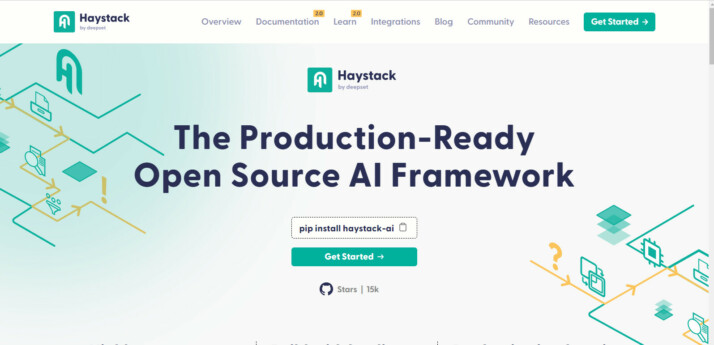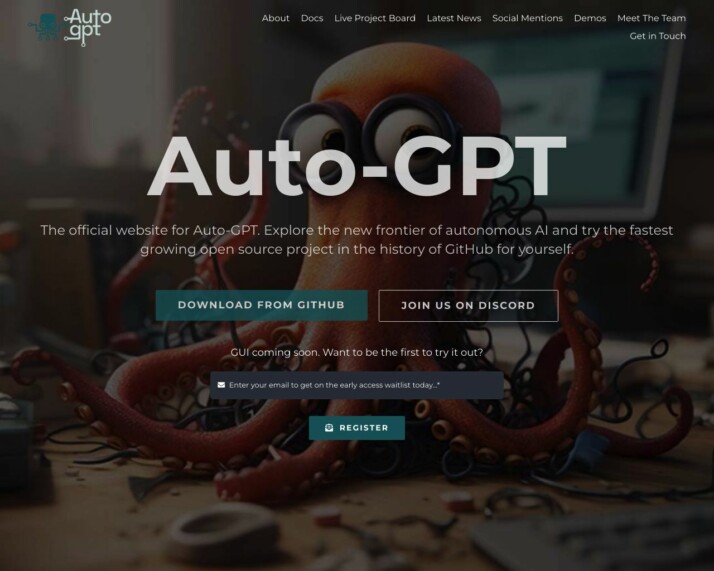Haystack vs. AutoGPT: AI Development Platforms Compared
Artificial intelligence reshapes how businesses operate, innovate, and compete. As AI development platforms evolve, two notable contenders have emerged: Haystack and AutoGPT. This comparison explores their unique approaches to AI agent creation, highlighting key features, strengths, and limitations. We’ll examine how these platforms empower developers to harness AI’s potential, from building production-ready applications to creating autonomous agents. By understanding the capabilities and trade-offs of Haystack vs. AutoGPT, you’ll gain valuable insights to guide your AI development strategy and make informed decisions about the tools best suited for your projects.
Haystack Overview
Haystack empowers developers to build production-ready applications leveraging Large Language Models (LLMs) and vector search. This open-source framework excels in retrieval-augmented generation, document search, and question answering. Haystack’s modular architecture allows developers to create custom search experiences and conversational chatbots by integrating various AI tools into flexible pipelines.
Haystack’s strength lies in its versatility and powerful capabilities. The framework supports AI agents that can utilize multiple tools to resolve complex queries, inspired by advanced AI architectures. This enables the creation of sophisticated applications capable of processing and generating human-like responses. Haystack also offers robust support for context and memory through its document stores and retrieval mechanisms, ensuring AI agents maintain relevance in extended interactions.


Haystack empowers developers to build production-ready applications leveraging Large Language Models (LLMs) and vector search.
Developers benefit from Haystack’s comprehensive ecosystem. The framework integrates seamlessly with popular AI models and platforms, including Hugging Face Transformers, Elasticsearch, OpenAI, and Anthropic. This extensive compatibility allows teams to leverage cutting-edge AI technologies without starting from scratch. Additionally, Haystack’s parent company, deepset, offers deepset Cloud—a commercial platform supporting the entire lifecycle of NLP application development, from prototyping to production deployment.
While Haystack provides powerful tools for AI development, it may present a steeper learning curve for non-technical users. The framework primarily caters to developers and data scientists comfortable with coding, as it lacks a visual builder or no-code editor. This focus on flexibility and customization through code may require more time investment for teams without strong programming backgrounds.
Haystack’s impact extends beyond its technical capabilities. The framework and its associated tools have garnered significant attention in the NLP community. With over 52 million downloads of their models as of August 2023, Haystack has demonstrated its widespread adoption and practical value in real-world AI applications.
AutoGPT Overview
AutoGPT revolutionizes AI agent development with its open-source platform. Released in March 2023, AutoGPT empowers developers to create autonomous AI agents capable of completing complex tasks without constant human input.
Leveraging OpenAI’s GPT-4, AutoGPT enables AI agents to self-prompt, break down tasks, and utilize internet resources to achieve predefined goals. This innovative approach allows for the automation of workflows across various domains, from software development to content creation and business operations.


AutoGPT empowers developers to create autonomous AI agents capable of completing complex tasks without constant human input.
AutoGPT’s unique features include code debugging, file management, and multimodal input processing. The platform has spawned specialized agents like ChefGPT for recipe generation, showcasing its versatility. However, users should be aware of potential limitations such as error susceptibility and high operational costs due to its recursive nature.
While AutoGPT marks a significant step towards artificial general intelligence (AGI), it faces challenges like the lack of long-term memory and the risk of infinite loops. These limitations highlight areas for future improvement as the platform continues to evolve.
AutoGPT’s open-source nature fosters collaboration and innovation within the tech community. As developers and researchers contribute to its advancement, AutoGPT remains at the forefront of autonomous AI agent development, offering a glimpse into the future of intelligent systems.
Feature Comparison
Haystack and AutoGPT offer distinct approaches to AI agent development, with key differences in their core components and security features. Haystack provides a robust framework for building production-ready applications using Large Language Models and vector search, excelling in retrieval-augmented generation and question answering. Its modular architecture allows for flexible pipeline creation, integrating various AI tools. In contrast, AutoGPT focuses on creating autonomous AI agents capable of completing complex tasks without constant human input, leveraging GPT-4 for self-prompting and task breakdown.
A significant gap exists in their development environments. Haystack, through deepset Cloud, supports the entire lifecycle of NLP application development from prototyping to production. AutoGPT, being primarily an open-source project, lacks this comprehensive hosted solution, potentially requiring more setup and management from users. In terms of security, Haystack likely offers more enterprise-grade features through deepset Cloud, including data encryption and OAuth support, while AutoGPT’s security measures are less defined in the available information.
Both platforms have limitations in visual building tools. Neither Haystack nor AutoGPT offers a no-code editor or visual builder, which could present challenges for non-technical users looking to create AI agents without extensive coding knowledge. This gap highlights an area where more user-friendly platforms like SmythOS have an advantage, offering intuitive drag-and-drop interfaces for agent creation.
Feature Comparison Table
| Haystack | AutoGPT | SmythOS | |
|---|---|---|---|
| CORE FEATURES | |||
| Hosted Agents (Dev, Production) | ✅ | ❌ | ✅ |
| Visual Builder | ❌ | ✅ | ✅ |
| No-Code Options | ❌ | ✅ | ✅ |
| Explainability & Transparency | ✅ | ❌ | ✅ |
| Audit Logs for Analytics | ✅ | ❌ | ✅ |
| Agent Work Scheduler | ❌ | ❌ | ✅ |
| SECURITY | |||
| Constrained Alignment | ❌ | ❌ | ✅ |
| IP Control | ❌ | ❌ | ✅ |
| COMPONENTS | |||
| Zapier APIs | ❌ | ✅ | ✅ |
| Data Lakes | ❌ | ❌ | ✅ |
| DEPLOYMENT OPTIONS (EMBODIMENTS) | |||
| Staging Domains | ❌ | ❌ | ✅ |
| Production Domains | ❌ | ❌ | ✅ |
| Deploy as Scheduled Agent | ❌ | ❌ | ✅ |
| DATA LAKE SUPPORT | |||
| Hosted Vector Database | ✅ | ❌ | ✅ |
| Sitemap Crawler | ❌ | ❌ | ✅ |
| YouTube Transcript Crawler | ❌ | ❌ | ✅ |
Best Alternative to Haystack and AutoGPT
SmythOS emerges as the superior alternative to Haystack and AutoGPT, offering a comprehensive agentic AI automation platform that addresses key limitations of its competitors. Our platform combines ease of use, an extensive feature set, and unlimited use cases to provide a powerful solution for businesses and developers alike.
Unlike Haystack and AutoGPT, SmythOS offers a visual builder with drag-and-drop functionality, making AI agent creation accessible to users of all skill levels. This intuitive interface significantly reduces development time and eliminates the need for extensive coding knowledge, a feature absent in both Haystack and AutoGPT.
SmythOS offers a visual builder with drag-and-drop functionality, making AI agent creation accessible to users of all skill levels.
SmythOS excels in versatility, supporting a wide range of AI models and integrations. While Haystack focuses on specific NLP tasks and AutoGPT relies heavily on GPT-4, our platform allows users to leverage multiple AI providers and APIs, creating more flexible and powerful agents. This adaptability enables SmythOS to cater to diverse industry needs, from customer service to complex data analysis.
Security and scalability set SmythOS apart from its competitors. We offer robust features like data encryption, OAuth support, and IP control, addressing enterprise-level security concerns that are less defined in AutoGPT. Additionally, our platform provides seamless scalability options, including staging and production environments, which are not explicitly offered by Haystack or AutoGPT.
SmythOS’s commitment to user empowerment extends beyond agent creation. We provide comprehensive debugging tools, explainable AI features, and detailed analytics, ensuring transparency and continuous improvement. These capabilities, combined with our platform’s ability to handle multimodal inputs and support multi-agent collaboration, position SmythOS as the most advanced and user-friendly option in the AI agent builder market.
Conclusion
Haystack and AutoGPT offer powerful AI development tools, each with unique strengths. Haystack excels in building production-ready applications with its modular architecture and robust support for retrieval-augmented generation. AutoGPT pushes the boundaries of autonomous AI agents, enabling complex task completion with minimal human input. Both platforms cater primarily to developers and data scientists, requiring significant technical expertise.
However, SmythOS emerges as the superior choice, addressing the limitations of both Haystack and AutoGPT. Our platform combines ease of use with advanced capabilities, offering a visual builder and no-code editor that democratizes AI development. We provide enterprise-grade security, scalability, and a vast integration ecosystem of over 300,000 connections.
SmythOS stands out with its “Create Once, Deploy Anywhere” philosophy, allowing users to build AI agents that seamlessly integrate across multiple platforms and services. From chatbots to APIs, our agents adapt to various deployment scenarios, maximizing flexibility and efficiency. This versatility, coupled with our intuitive interface, empowers both technical and non-technical users to harness the full potential of AI.
Experience the future of AI development with SmythOS. Explore our diverse range of AI-powered agent templates to jumpstart your projects, or create a free account to build unlimited AI agents with no time limit. Unleash the power of AI for your business and revolutionize your workflow today.
Last updated:
Disclaimer: The information presented in this article is for general informational purposes only and is provided as is. While we strive to keep the content up-to-date and accurate, we make no representations or warranties of any kind, express or implied, about the completeness, accuracy, reliability, suitability, or availability of the information contained in this article.
Any reliance you place on such information is strictly at your own risk. We reserve the right to make additions, deletions, or modifications to the contents of this article at any time without prior notice.
In no event will we be liable for any loss or damage including without limitation, indirect or consequential loss or damage, or any loss or damage whatsoever arising from loss of data, profits, or any other loss not specified herein arising out of, or in connection with, the use of this article.
Despite our best efforts, this article may contain oversights, errors, or omissions. If you notice any inaccuracies or have concerns about the content, please report them through our content feedback form. Your input helps us maintain the quality and reliability of our information.
